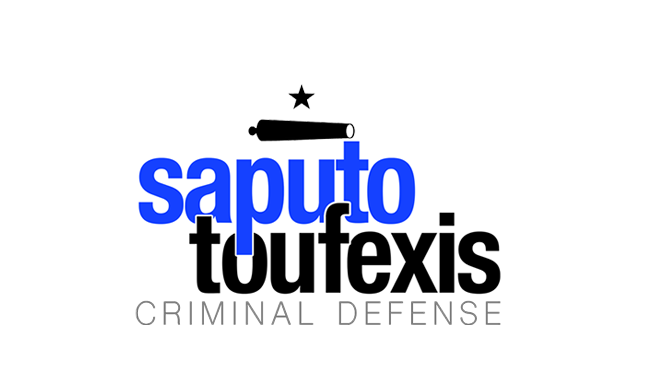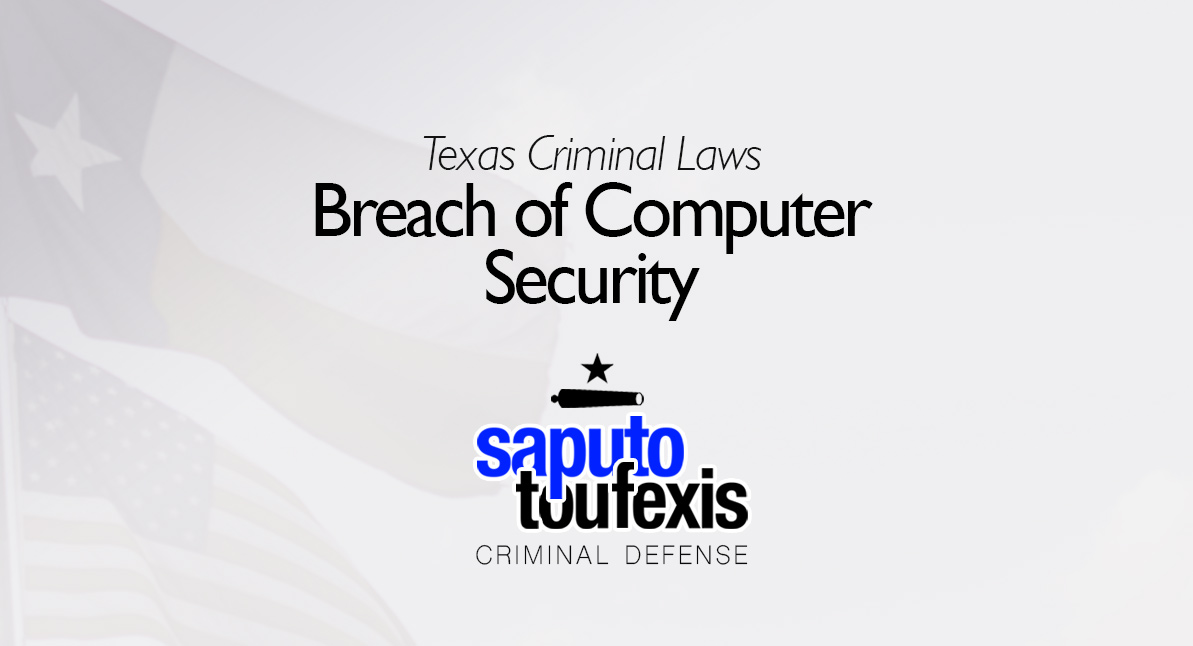The Texas Breach of Computer Security law gives police the right to arrest you if they believe you accessed a computer, computer network, or computer system without the consent of the owner.
FAQs about the
Breach of Computer Security law in Texas
- What is the current Texas law about Breach of Computer Security?
- What is the penalty for a Texas Breach of Computer Security offense?
- How can I be charged with a Breach of Computer Security offense in Texas?
- What is the statute of limitations for Breach of Computer Security in Texas?
- Can you get probation for Breach of Computer Security in Texas?
- What level of crime is Breach of Computer Security in Texas?
The Breach of Computer Security law also makes it illegal to access computers and networks, even with the effective consent of the owner, if you do it maliciously and in violation of a contract or rules established by the owner. This might be considered the Texas law against hacking.
Have you been charged with Breach of Computer Security? Contact us today to discuss legal representation.
or Text or Call (888) 239-9305
As part of the patchwork of cybersecurity laws in Texas, the Breach of Computer Security offense prohibits both hacking activities and activities akin to electronic theft or criminal mischief.
The Texas legislature codified this criminal offense in Texas Penal Code Section 33.02. The law was not updated in 2025. In fact, this law has not been amended since 2015.
The Penal Code classifies the Texas Breach of Computer Security law under Title 7 “Offenses Against Property,” Chapter 33 “Computer Crimes.” Learn more about the Texas offense of Breach of Computer Security below.
What is the current Texas law about Breach of Computer Security?
AV Preeminent Texas lawyer Paul Saputo provides the current law defining Breach of Computer Security in Penal Code Section §33.02, as follows:[1]
(a) A person commits an offense if the person knowingly accesses a computer, computer network, or computer system without the effective consent of the owner.
(b) An offense under Subsection (a) is a Class B misdemeanor, except that the offense is a state jail felony if:
(1) the defendant has been previously convicted two or more times of an offense under this chapter; or
(2) the computer, computer network, or computer system is owned by the government or a critical infrastructure facility.
(b-1) A person commits an offense if, with the intent to defraud or harm another or alter, damage, or delete property, the person knowingly accesses:
(1) a computer, computer network, or computer system without the effective consent of the owner; or
(2) a computer, computer network, or computer system:
(A) that is owned by:
(i) the government; or
(ii) a business or other commercial entity engaged in a business activity;
(B) in violation of:
(i) a clear and conspicuous prohibition by the owner of the computer, computer network, or computer system; or
(ii) a contractual agreement to which the person has expressly agreed; and
(C) with the intent to obtain or use a file, data, or proprietary information stored in the computer, network, or system to defraud or harm another or alter, damage, or delete property.
The hacking offense described in subsection (a) is more broad than the subsection (b-1) offense, applying to any knowing access of a computer or network without the owner’s consent. The subsection (b-1) offense covers that as well, but it also covers situations where someone has permission to access a computer or network but does so with an intent to cause damage or delete files.
For instance, the subsection (b-1) offense could apply to hacking publicly-available internet websites or deleting files on a computer provided by your employer, but the state must prove that you did so with the intent to defraud or commit harm or one of the other listed intentions. In addition, the clear and conspicuous prohibition or contractual agreement elements of the offense put the onus to some extent on the network administrator or owner. The clear and conspicuous prohibitions might be satisfied with terms of service linked from a website or a company policy handbook.
What is the penalty for a Texas Breach of Computer Security offense?
Hacking convictions for Breach of Computer Security under subsection (a) are punished by default as a Class B misdemeanor,[2] with a maximum possible fine under Texas state law of up to $2,000 and jail time of up to 180 days.
But if the offense falls under subsection (a), and the defendant has been convicted of this offense two or more times or the computer breached was a government computer, then a conviction for Breach of Computer Security in Texas is punished as a state jail felony.[3]
If the offense falls under subsection (b-1), and the total amount of money involved is less than $100, then a conviction for Breach of Computer Security in Texas is punished as a Class C misdemeanor.[4]
If the offense falls under subsection (b-1), and the total amount of money involved is $100 or more but less than $750, then a conviction for Breach of Computer Security in Texas is punished as a Class B misdemeanor.[5]
If the offense falls under subsection (b-1), and the total amount of money involved is $750 or more but less than $2,500, then a conviction for Breach of Computer Security in Texas is punished as a Class A misdemeanor.[6]
If the offense falls under subsection (b-1), and the total amount of money involved is $2,500 or more but less than $30,000, then a conviction for Breach of Computer Security in Texas is punished as a state jail felony.[7]
If the offense falls under subsection (b-1), and the total amount of money involved is $30,000 or more but less than $150,000, then a conviction for Breach of Computer Security in Texas is punished as a Felony of the Third Degree.[8]
If the offense falls under subsection (b-1), and the total amount of money involved is $150,000 or more but less than $300,000, and the computer is owned by the government or if you receive identifying information from one computer, then a conviction for Breach of Computer Security in Texas is punished as a Felony of the Second Degree.[9]
If the offense falls under subsection (b-1), and the total amount of money involved is $300,000 or more, and you obtained identifying information from two or more computers, then a conviction for Breach of Computer Security in Texas is punished as a Felony of the First Degree.[10]
How can I be charged with a Breach of Computer Security offense in Texas?
You can be charged with Breach of Computer Security in Texas if the state’s attorneys believe that each of the elements of either 33.02(a) or (b-1) as described in the section above have been met
What is the statute of limitations for Breach of Computer Security in Texas?
Misdemeanor level Breach of Computer Security charges have a two-year limitations period.[11] Felony level offenses follow the default felony limitations period rule, which specifies a three-year limitations period.[12]
Can you get probation for Breach of Computer Security in Texas?
The Texas Code of Criminal Procedure allows both judges and juries to grant probation for Breach of Computer Security, and judges are also allowed to accept deferred adjudication plea deals.[13]
Note, however, that no matter the offense, neither judges nor juries may recommend community supervision for any suspended sentence of over 10 years.[14] Also, judges may not grant community supervision after a conviction if (1) the defendant used or exhibited a deadly weapon during the commission of the felony or immediate flight thereafter and (2) the defendant used or exhibited the deadly weapon himself or was a party to the offense and knew that a deadly weapon would be used or exhibited.[15]
What level of crime is Breach of Computer Security in Texas?
The punishment classification for the Breach of Computer Security offense in the code ranges from a Class C misdemeanor to a first degree felony. The punishment range varies depending primarily on the amount of money involved.
Learn more about the penalty range for this offense in the section above.
Legal References:
^1. Texas Penal Code §33.02. This law is current as of 2025.^2. Texas Penal Code Section 33.02(b)^3. Texas Penal Code Section 33.02(b)(1)&(2)^4. Texas Penal Code Section 33.02(b-2)(1)^5. Texas Penal Code Section 33.02(b-2)(2)^6. Texas Penal Code Section 33.02(b-2)(3)^7. Texas Penal Code Section 33.02(b-2)(4)^8. Texas Penal Code Section 33.02(b-2)(5)^9. Texas Penal Code Section 33.02(b-2)(6)^10. Texas Penal Code Section 33.02(b-2)(7)^11. Code of Criminal Procedure 12.02(a)^12. See Code of Criminal Procedure 12.01(11)^13. See Chapter 42A, Texas Code of Criminal Procedure, Art. 42A.054, Art. 42A.056, Art. 42A.102^14. Art. 42A.053(c), Texas Code of Criminal Procedure^15. Art. 42A.054(b), Texas Code of Criminal Procedure










